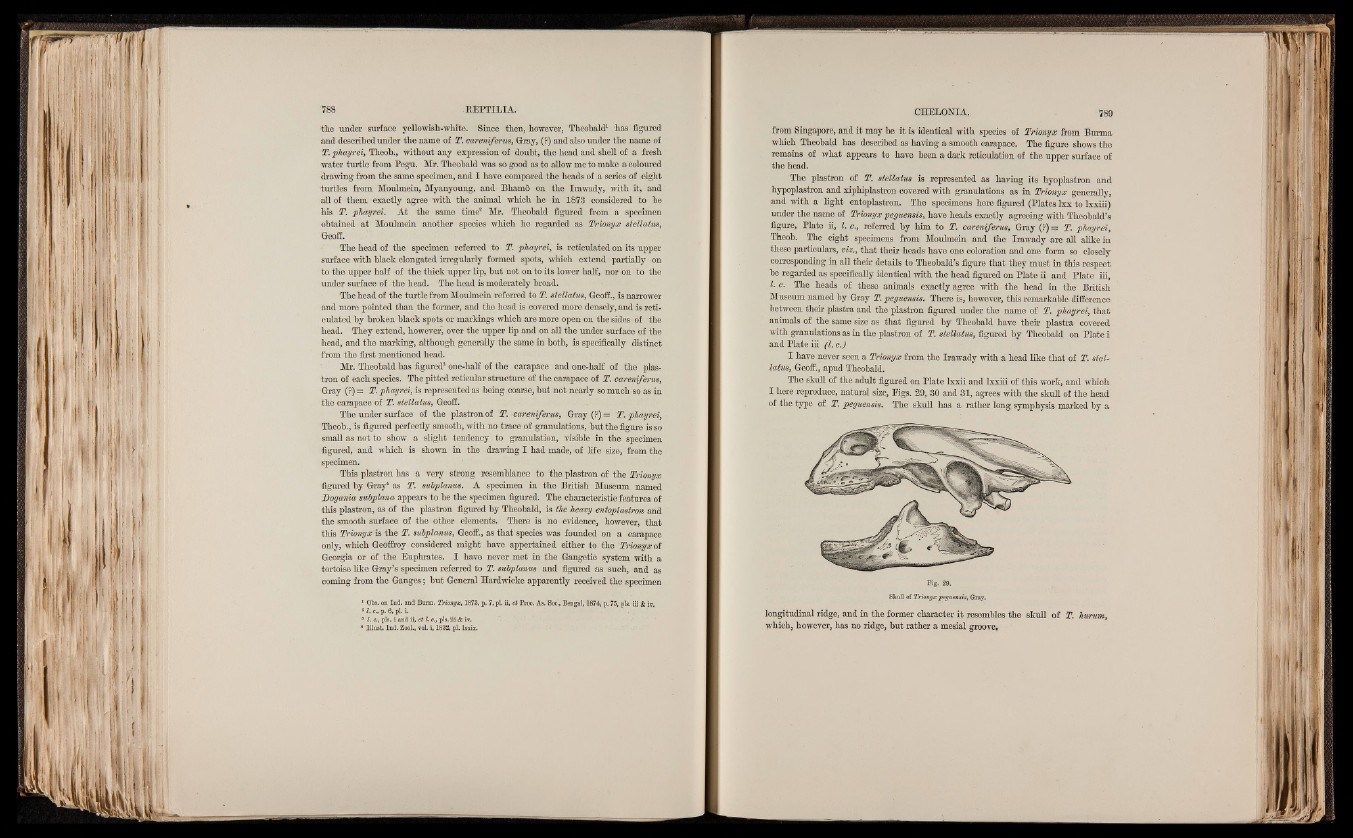
Il
the under surface yellowish-white. Since then, however, Theobald1 has figured
and described under the name of T. careniferus, Gray, (?) and also under the name of
T. phayrei, Theob., without any expression of doubt, the head and shell of a fresh
water turtle from Pegu. Mr. Theobald was so good as to allow me to make a coloured
drawing from the same specimen, and I have compared the heads of a series of eight
turtles from Moulmein, Myanyoung, and Bham6 on the Irawady, with it, and
all of them exactly agree with the animal which he in 1878 considered to he
his T. phayrei. At the same time2 Mr. Theobald figured from a specimen
obtained at Moulmein another species which he regarded as Trionyx stellatus,
Geoff.
The head of the specimen referred to T. phayrei, is reticulated on its upper
surface with black elongated irregularly formed spots, which extend partially on
to the upper half of the thick upper lip, hut not on to its lower half, nor on to the
under surface of the head. The head is moderately broad.
The head of the turtle from Moulmein referred to T. stellatus, Geoff., is narrower
and more pointed than the former, and the head is covered more densely, and is reticulated
by broken black spots or markings which are more open on the sides of the
head. They extend, however-, over the upper lip and on all the under surface of the
head, and the marking, although generally the same in both, is specifically distinct
from the first mentioned head.
Mr. Theobald has figured3 one-half of the carapace and one-half of the plastron
of each species. The pitted reticular structure of the carapace of T. careniferus,
Gray (?) = T. phayrei, is represented as being coarse, but not nearly so much so as in
the carapace of T. stellatus, Geoff.
The under surface of the plastron of T. careniferus, Gray (?)= T. phayrei,
Theob., is figured perfectly smooth, with no trace of granulations, but the figure is so
small as not to show a slight tendency to granulation, visible in the specimen
figured, and which is shown in the drawing I had made, of life size, from the
specimen.
This plastron has a very strong resemblance to the plastron of the Trionyx
figured by Gray4 as T. subplmus. A specimen in the British Museum named
Dogania subplma appears to be the specimen figured. The characteristic features of
this plastron, as of the plastron figured by Theobald, is the heavy entoplastron and
the smooth surface of the other elements. There is no evidence, however, that
this Trionyx is the T. subplanus, Geoff., as that species was founded on a carapace
only, which Geoffroy considered might have appertained either to the Trionyx of
Georgia or of the Euphrates. I have never met in the Gangetic system with a
tortoise like Gray’s specimen referred to T. subplcmm and figured as such, and as
coming from the Ganges; but General Hardwicke apparently received the specimen
1 Obs. on Ind. and Bunn. Trionyx, 1873, p. 7, pl. ii, et Proo. As. Soc., Bengal, 1874, p. 75, pis. i
* 7. C.,p..6, pi. M
3 I- c., pis. i and ii, e t l.c., p ls.iii & iv.
• Illust. Ind. ZooL, voL i, 1832, pi. In is .
from Singapore, and it may be it is identical with species of Trionyx from Burma
which Theobald has described as having a smooth carapace. The figure shows the
remains of what appears to have been a dark reticulation of the upper surface of
the head.
The plastron of T. stellatus is represented as having its hyoplastron and
hypoplastron and xiphiplastron covered with granulations as in Trionyx generally,
and with a light entoplastron. The specimens here figured (Plates lxx to lxxiii)
under the name of Trionyx peguensis, have heads exactly agreeing with Theobald’s
figure, Plate ii, I. c., referred by him to T. careniferus, Gray (?) == T. phayrei,
Theob. The eight specimens from Moulmein and the Irawady are all alike in
these particulars, viz., that their heads have one coloration and one form so closely
corresponding in all their details to Theobald’s figure that they must in this respect
be regarded as specifically identical with the head figured on Plate ii and Plate iii,
| | c- heads of these animals exactly agree with the head in the British
Museum named by Gray T. peguensis. There is, however, this remarkable difference
between their plastra and the plastron figured under the name of T. phayrei, that
animals of the same size as that figured by Theobald have their plastra covered
with granulations as in the plastron of T. stellatus, figured by Theobald on Plate i
and Plate iii (I. c.)
I have never seen a Trionyx from the Irawady with a head like that of T. stellatus,
Geoff., apud Theobald.
The skull of the adult figured on Plate lxxii and lxxiii of this work, and which
I here reproduce, natural size, Eigs. 29, 30 and 31, agrees with the skull of the head
of the type of T. peguensis. The skull has a rather long symphysis marked by a
Pig. 29.
Skull of Trionyx peguensis, Gray.
longitudinal ridge, and in the former character it resembles the skull of T. hwrum,
which, however, has no ridge, but rather a mesial groove,